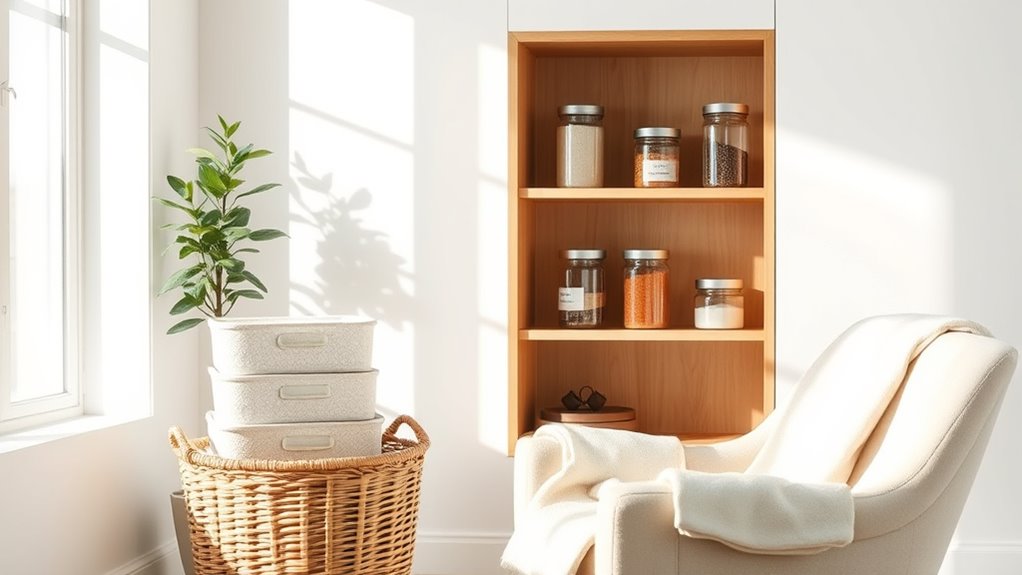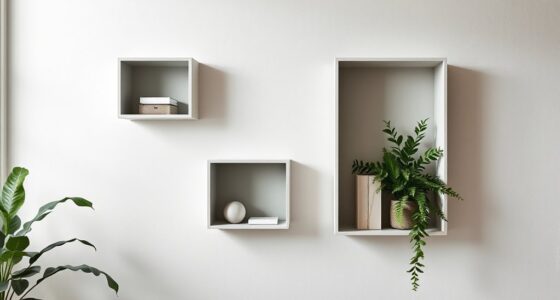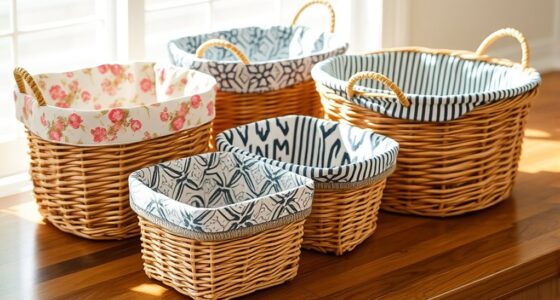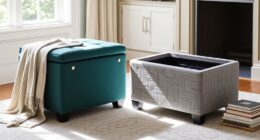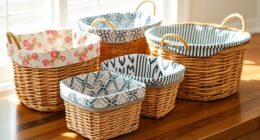When I think about the ultimate decluttering items everyone needs, I consider things that spark joy, serve a purpose, or hold significant memories. I've learned to evaluate my attachments and recognize what contributes positively to my life. Grouping similar items makes decisions easier. Whether it's furniture, keepsakes, or just everyday essentials, each piece should enhance my space. If you want to find out how to optimize your home and keep emotional burdens at bay, just keep exploring!
Key Takeaways
- Storage Bins: Utilize clear storage bins to categorize and store items, making it easier to track possessions and simplify decision-making.
- Labeling System: Implement a labeling system for boxes and bins to quickly identify contents and streamline the decluttering process.
- Donation Box: Keep a designated donation box handy to instantly place items you decide to let go, promoting regular decluttering.
- Vertical Shelving: Invest in vertical shelving to maximize space and organize items efficiently, reducing clutter while maintaining accessibility.
- Memory Journal: Create a memory journal to document sentimental items' stories, allowing you to appreciate memories without needing to hold onto the physical items.
The Sentimental Persons Guide to Decluttering

If you're someone who struggles to part with belongings due to their sentimental value, "The Sentimental Persons Guide to Decluttering" is tailored just for you. This book offers practical strategies that truly resonate with me. It helps tackle the emotional hurdles we face when letting go of cherished items. I found the advice on grouping similar items together incredibly useful; it simplified my decision-making process. Plus, the book reassures us that gifts shouldn't feel like obligations. By shifting my perspective, I've started to confront my clutter, making room for a more minimalist lifestyle. It's a valuable resource for anyone like us.
Best For: Individuals who struggle with sentimental attachments to possessions and seek practical guidance for decluttering their homes.
Pros:
- Provides relatable strategies for overcoming emotional challenges associated with letting go of items.
- Encourages a perspective shift, helping readers view gifts as memories rather than obligations.
- Simplifies the decluttering process by advocating for grouping similar items together.
Cons:
- Some readers may find the information to be basic and lacking advanced techniques.
- The emotional topics may not resonate with those who do not have strong sentimental attachments.
- Readers looking for a strict step-by-step guide might find the approach more flexible than structured.
Factors to Consider When Choosing These Decluttering Items That Are Perfect for Everyone
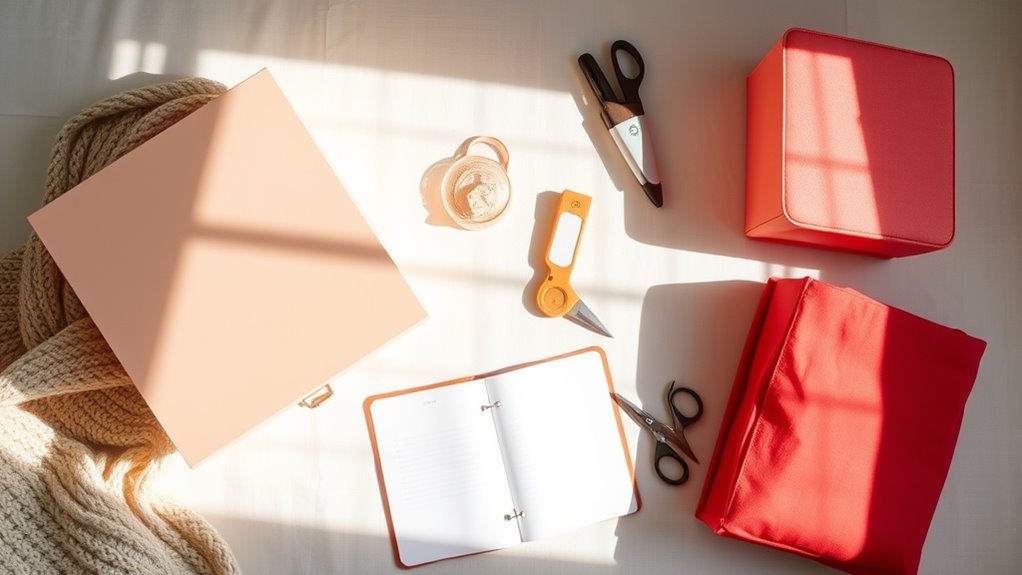
When I choose decluttering items, I think about my personal attachment to each piece and how much space I realistically have. I also consider the purpose of the items and assess their emotional weight. Grouping similar items helps me make clearer decisions about what to keep and what to let go.
Personal Sentimental Attachment
While tackling clutter, I often find that personal sentimental attachment complicates the process. It's tough to let go of items tied to cherished memories or emotional connections. I've felt that guilt when considering the disposal of gifts or family heirlooms; it's easy to see them as obligations rather than just things. This emotional weight can lead to anxiety and overwhelm, making me postpone decluttering. To combat this, I've learned to shift my perspective—recognizing that my worth isn't defined by these items. Grouping similar items together has also helped me track my possessions and simplify decisions on what to let go. Ultimately, I aim for a space that reflects who I am today, free from unnecessary emotional burdens.
Space Management Considerations
Letting go of sentimental items can be a challenge, but once I've made that decision, it's time to focus on how to manage the space I have effectively. I start by evaluating the available space in my home, as this helps me prioritize what to keep or remove. Understanding each room's dimensions allows me to visualize storage options. I also utilize vertical space with shelves and wall-mounted storage, which maximizes capacity without cluttering the floor. It's important to contemplate the flow of movement, ensuring I can navigate easily. Finally, assessing each room's purpose helps me identify essential items, striking a balance between my sentimental belongings and practical needs. This approach transforms my space into an organized haven.
Purpose of Items
Evaluating the purpose of items in my home is essential for effective decluttering. I focus on their utility, sentimental value, and the joy they bring. If an item doesn't serve a functional purpose or contribute positively to my daily life, it's time to contemplate letting it go. I assess sentimental items carefully, distinguishing between meaningful keepsakes and those I can part with guilt-free. Understanding the intended purpose of my possessions helps me prioritize what to keep, donate, or discard. This mindful approach fosters a deeper connection to what truly matters, creating a more organized and fulfilling living space. In this process, I discover the freedom that comes with surrounding myself with only what I genuinely value.
Emotional Weight Assessment
Understanding the purpose of my items lays the groundwork for a more profound emotional weight assessment. I've realized that it's vital to recognize the feelings tied to each possession. This helps me differentiate between items that genuinely hold sentimental value and those that just evoke guilt or obligation. By acknowledging the emotional challenges in letting go, I can shift my perspective and view belongings as memories rather than burdens. This clarity guides me in prioritizing what truly enhances my life. Engaging in emotional weight assessment has also alleviated the stress and guilt I often felt while decluttering. It's an important step that allows me to create a more meaningful and organized living space.
Grouping Similar Items
When I start decluttering, grouping similar items together makes the process feel much more manageable. By organizing my clothing, books, or kitchenware into categories, I gain a clearer overview of what I own. This clarity helps me assess how much I really need in each category. Focusing on one type of item at a time reduces the emotional overwhelm that often comes with decluttering. It's easier to spot duplicates or items that no longer serve a purpose, leading to more effective decisions. Plus, it highlights areas where I might have too much, prompting me to reflect on my consumption habits. Ultimately, this method keeps me accountable and makes decluttering less intimidating.
Donation and Repurposing Options
Choosing what to do with items I no longer need can feel overwhelming, but exploring donation and repurposing options makes the process easier. First, I research local charities to find those that align with their mission, ensuring my items will truly help others. For items that aren't suitable for donation, I get creative by repurposing them; turning old clothing into rags or upcycling furniture can breathe new life into forgotten pieces. Many non-profits even offer pick-up services for larger items, eliminating transportation stress. I also consider donating to community centers or schools, giving items a chance for new uses in craft projects. Before donating, I always inspect my items for damage, as most organizations prefer gently used goods.
Long-Term Maintenance Strategies
Although maintaining a clutter-free environment can seem challenging, implementing long-term maintenance strategies makes it manageable. I find establishing a regular decluttering schedule, like monthly or quarterly, keeps items from piling up. The "one in, one out" rule really helps, too—every new item I bring in means I let go of something else. Utilizing organizational systems, such as labeled bins or clear containers, makes finding and storing items a breeze, reducing my urge to keep unnecessary things. I also developed a decision-making framework to evaluate each item based on its usefulness and sentimental value. Finally, shifting my mindset to prioritize experiences over possessions has fostered a more sustainable decluttering practice, making my space feel lighter and more inviting.
Frequently Asked Questions
What Are the Best Storage Solutions for Small Spaces?
When it comes to storage solutions for small spaces, I've found a few that really work wonders. I love using under-bed storage bins; they keep items out of sight but easily accessible. Vertical shelving has also been a game changer for me, maximizing wall space. Don't forget about multi-functional furniture, like ottomans with storage inside. These options not only save space but also keep my home organized and clutter-free, which I really appreciate!
How Do I Handle Guilt When Discarding Sentimental Items?
Tossing sentimental items feels like untangling a web of memories. I've faced that guilt too, but I remind myself that the memories live on in my heart, not in physical objects. I ask myself if the item truly sparks joy or if it's just weighing me down. I take a photo to preserve the memory, then let go. It's liberating! Embrace the freedom that comes with making space for new experiences and memories.
Can Decluttering Improve Mental Health and Well-Being?
Absolutely, I've found that decluttering can greatly improve mental health and well-being. When I clear out my space, I feel lighter and more focused. It's like lifting a weight off my shoulders. I've noticed a decrease in anxiety and stress levels, too. A tidy environment allows me to think clearly and boosts my mood. So, if you're feeling overwhelmed, consider tackling some clutter—it might just transform your mindset like it did for me!
What's the Most Effective Method for Organizing Decluttered Items?
Have you ever felt overwhelmed by clutter? I've found that the most effective method for organizing decluttered items is to categorize them. I sort my belongings into groups like "keep," "donate," and "trash." Then, I create designated spaces for each category using bins or shelves. This way, everything has a home, making it easier to find what I need. Plus, it feels great to see order where chaos once reigned!
How Often Should I Reassess My Decluttering Items?
I usually reassess my decluttering items every six months. It helps me stay on top of what I truly need and what just takes up space. I find that seasonal changes often bring new perspectives on what I use. If I notice items gathering dust, it's a clear sign they should go. Keeping my space fresh and functional keeps me motivated, so regular check-ins really make a difference for me.
Conclusion
In my journey to declutter, I've discovered that the right items can truly transform our spaces and lives. By thoughtfully evaluating our attachments and the purpose of our belongings, we can create an environment that feels both functional and serene. Isn't it time we let go of what weighs us down and embrace a lighter, more intentional lifestyle? With the right strategies in place, maintaining this new clarity becomes not just possible, but rewarding.
